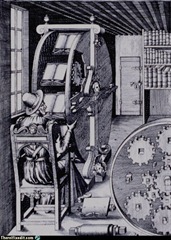 The great thing about an e-book reader is the way it allows you to have access to dozens of books on your device, each one staying open to exactly where you left it when you go back to it. You may not even think about how much of a benefit this is until you consider the mechanisms devised in the 16th century to try to provide the same access to physical books.
The great thing about an e-book reader is the way it allows you to have access to dozens of books on your device, each one staying open to exactly where you left it when you go back to it. You may not even think about how much of a benefit this is until you consider the mechanisms devised in the 16th century to try to provide the same access to physical books.
The “There, I Fixed It” section of Failblog covers the 16th-century “bookwheel” revolving bookstand, intended to allow researchers to cross-reference between multiple volumes with as much ease as they possibly could.
Based on the design of a waterwheel, the bookwheel would hold over a dozen separate titles, all sitting open at the same angle. Using either hand or foot controls, the reader could easily sort through the books he collected at ease without the fear of losing track of his place.
Some such devices were even built—and Thomas Jefferson used a smaller shelf made on a similar principle that rotated instead of revolving.
Of course, we now have something even better in the e-book reader—but it’s interesting to see the sorts of solutions inventive minds came up with back then. These revolving readers would be very much at home in any steampunk setting.
(Found via BoingBoing.)































